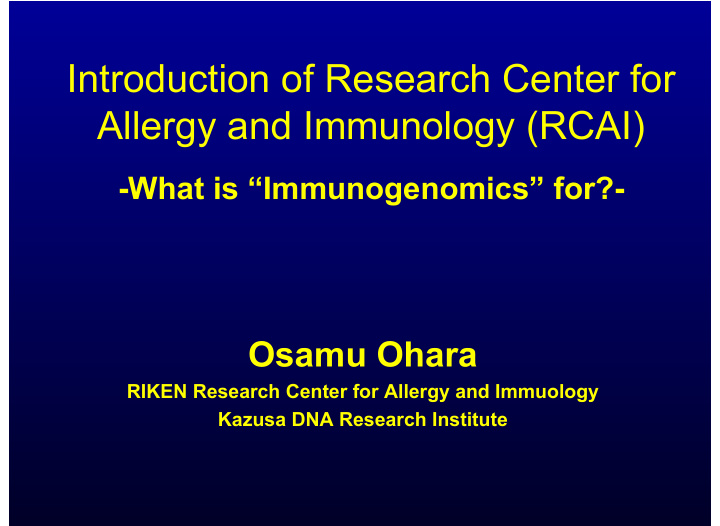



Introduction of Research Center for Allergy and Immunology (RCAI) -What is “Immunogenomics” for?- Osamu Ohara RIKEN Research Center for Allergy and Immuology Kazusa DNA Research Institute
Organization of RIKEN Research Center for Allergy and Immunology 研究グループ 研究ユニット 研究チーム
Central Instruments for genomics Fluorescent gel image scanner High-resolution fluorescent image scanner Plasmid preparation robot Automated sample preparation DNA microarray system robot for MS analysis Liquid dispensing robot Real-time PCR analyzer Mass spec. instruments Thermal cyclers Computer data mining system SPR analysis instrument Capillary DNA sequencers
From Genes to Immune systems Analysis of DNA structure ( Gene/Transcript analysis system ) Availability of comprehensive collections of human/mouse cDNA clones RCAI/Kazusa cDNA clones RIKEN FANTOM clones PC cluster computer High-throughput DNA sequencers DNA microarray system Genome/protein databases DNA microarray data Expression profiling of tens of thousands of genes Data integration and Data mining
From Proteins to Immune Systems ( Protein analysis system ) Isolation of proteins of interest Detection of proteins Separation of proteins of interest High-throughput sample preparation robot Differential detection of fluorescently labeled proteins 2D gel electrophoresis Identification of proteins Nano-LC-MS/MS system MALDI-TOF Mass spectrometer
時間軸と空間軸が捨象されている Genome Genome TR(transcribed region)ome ORFome Protein (Ab) microarray DNA microarray 2D gel electrophoresis SAGE etc. etc Snapshots of transcriptome/proteome Real-world Transcriptome Real-world Proteome Cell/Tissue Cell/Tissue 高い空間・時間依存性をもつ Real-world Biological System
Immunogenomics Immunogenomics Focused functional genomics Focused functional genomics for Immunology for Immunology 免疫系に関与する細胞のトランスクリプトーム・プロテオーム 免疫系に関与する細胞のトランスクリプトーム・プロテオーム スナップショットから免疫現象の理解に向かう スナップショットから免疫現象の理解に向かう ーゲノム情報に依拠した免疫システムの理解 ゲノム情報に依拠した免疫システムの理解ー ー ー
Omics Approaches Genome Information Proteomic analysis 2D gel electrophoretic analysis followed by mass spectrometry Protein Interaction Network Transcriptomic analysis Comprehensive understanding of the immune system Etiology of the immune disorders
Omics アプローチとは従来の生命科学研究 のアプローチと何が違うのか? • データ量? データの「量」は本質的な違いを与えるものではない。 しかし、しばしば実験手法で便宜的に区別されている 場合が見かけられる。 • 仮説に誘導されているかどうか? すべての生命現象がゲノムにコードされた遺伝子の振る舞いで記述 されているというドグマの下の仮説形成型のアプローチであるか どうかが、Omicsと従来のアプローチを峻別するものである 情報科学への期待は、正にこうしたOmicsアプローチの 実現へ向けてのものである
DNA マイクロアレイの原理 癌細胞由来のRNAを鋳型に 正常細胞由来のRNAを鋳型 逆転写させて調製したCy5 に逆転写させて調製した ラベルの1本鎖cDNA Cy3ラベルの1本鎖cDNA 競合的なハイブリダイゼーション 個別の遺伝子に相当する DNAをアレイ化したもの 2つの生理的に異なる状態で発現 レベルの異なっている遺伝子を同定 し、その中の遺伝子に今まで知られ ている機能では予想されない振る舞 いがみられるかどうかを調べる。 包括的解析ではあるが、Omics的な アプローチとはちょっと違うのでは ….
The Cycle of Knowledge IDEAS Synthesis Hypothesis Induction Analysis Abduction Deduction DATA Hypothesis-driven vs. Hypothesis-free science
Current needs of real-world immunologists to “Omics” studies • Fill the gap between the physiological Fill the gap between the physiological • immune responses and the molecular events immune responses and the molecular events Detection of changes at the mRNA and/or protein levels mRNA → DNA microarray Protein → 2D Gel electrophoresis/MS LC/MS/MS Detection of changes in transcriptional and/or translational states or in chromatin structure
mRNA と蛋白質レベルは独立な mRNA と蛋白質レベルは独立な パラメータである パラメータである mRNA レベル 蛋白質の合成速度を規定 レベル 蛋白質の合成速度を規定 mRNA 発現量を包括的に測定しうる 発現量を包括的に測定しうる 蛋白質レベル 合成速度と分解速度のバランスで 蛋白質レベル 合成速度と分解速度のバランスで 決定される 決定される たんぱく質レベルの レベルの包括的 包括的な測定は な測定は現在の技術ではまだ 現在の技術ではまだ困難 困難。 。 たんぱく質 しかし、もし判れば 、もし判ればそれ それは は生体機能に直結している 生体機能に直結している しかし 両者を追跡することが生命現象の理解には必須 両者を追跡することが生命現象の理解には必須
mRNAレベルの包括的な測定 DNA マイクロアレイの原理 癌細胞由来のRNAを鋳型に 正常細胞由来のRNAを鋳型 逆転写させて調製したCy5 に逆転写させて調製した ラベルの1本鎖cDNA Cy3ラベルの1本鎖cDNA 今後のバイオ分析機器は、 コンピュータの世界で起こ 競合的なハイブリダイゼーション ったことが再現されていく と言われている。 個別の遺伝子に相当する 「ダウンサイジング」が一つの DNAをアレイ化したもの キーワードであり、DNAマイクロ アレイはその先駆けである Y 座標軸( Xi, Yi )のハイブリダイゼー ションシグナルが遺伝子 i の mRNA 量に相関する。 x
Examples of 2D protein map X (pI) X (pI) Y (Mw) Y (Mw) Protein spots identified by PMF or LC-MS/MS analysis Quantities of gene products i , Q i , are expressed by the staining intensities of protein spots at the positions (X i , Y i ) on 2D map.
Quantitative protein 2D map of the immune system 2490 3478 2582 3479 020918S1KMSS-IEFLS1_20 020918S1WMSS-IEFLS1_20 ① 020918s1kmss-iefls1_20a ② 020918s1wmss-iefls1_20a Ref. Spot Volume Peak Height Area Height / Area Volume / Area Volume Peak Height Area Height / Area Volume / Area 2490 1 1 1 1 1 1.423 -1.055 1.654 -1.745 -1.163 2582 1 1 1 1 1 1.215 -1.149 1.518 -1.745 -1.249 3478 1 1 1 1 1 -3.85 -2.498 -2.489 -1.004 -1.547 3479 1 1 1 1 1 3.746 1.734 2.3 -1.326 1.629 Volume Once amounts of proteins are expressed quantitatively, the data can be analyzed in exactly the same way as the DNA microarray data
Differential Fluorescent 2D Protein Map Co-electrophoresed two differentially fluoresecent labeled protein samples Cell B Cell A Merge More sensitive than fluorescent protein detection!
Conventional “ “Omics Omics” ” Routine Routine Conventional 1. DNA microarray analysis 2. 2D gel analysis or LC/MS/MS analysis 1. Confirmation of modulated genes by real-time PCR or RNA blotting analysis 2. Confirmation of modulated proteins by protein blotting analysis When changes are observed only at the protein level, they are frequently considered to be biologically significant. However, when the changes at the mRNA level are not accompanied by those at the protein level, their biological significance are ambiguous.
Current concerns in proteomic analysis Current concerns in proteomic analysis • Low comprehensiveness DNA microarray ~Tens of thousands of genes less than 1 copy mRNA/cell Protein 2D analysis <1000 protein spots/gel more than 50 fmole/spot How to obtain protein profiles more comprehensively and more sensitively
Beyond the identification of Beyond the identification of human transcribed sequences human transcribed sequences Identification and characterization of proteins encoded by the transcripts Protein primary structure in vivo (post-translational modifications) Cellular and subcellular localization Protein-Protein interaction network Quantitative protein level profiling
What is required to move beyond the What is required to move beyond the identification of transcribed sequences? identification of transcribed sequences? High-throughput platforms to analyze proteins and their functions + A non-redundant collection of cDNAs which can produce authentic proteins
How to fill the gap between the How to fill the gap between the genome and the proteome proteome genome and the • Preparation of affinity capture reagents which can specifically detect the gene products of interest with high affinity Identification and characterization of the gene products in vivo Gene product of interest Tag Molecular mass and pI Post-translational modifications Interacting protein partners Cellular and subcellular localization High-affinity capture reagent Complementation of the in vitro results!
Recommend
More recommend